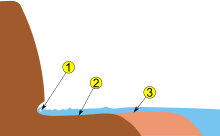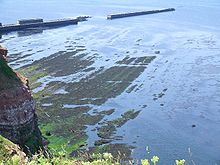Surf platform


A surf platform , also known as a rock chute , is an almost flat rock surface on a cliff coast that was created by the abrasive effect of the surf .
features
The platform, which is slightly inclined towards the sea , is located in front of the cliff coast and mostly dries out at low tide . The abrasion surface extends as far into the depth as it can be shaped by the waves on the sea floor and merges into the shelf towards the sea .
Individual rock needles or protrusions that have remained on the chute as erosion remains are known as surf pillars . A well-known example in Germany is the 47-meter-high “ Lange Anna ” on the northern tip of the island of Helgoland.
Geological features
Surf platforms can only be found on sections of the coast whose cliffs consist of relatively erosion-resistant solid rock ( conglomerate , sandstone , limestone , igneous or metamorphic rocks ). If it is made of loose rock or solid rock that is relatively susceptible to erosion (especially claystone ), a sand or rubble chute with a beach forms.
With sedimentary rocks, the spatial position of the layers is also decisive for the formation of a surf platform. If the layers are relatively steep and perpendicular to the coastline, there may not be a closed rock platform, but only a series of layer ribs .
Surf platforms formed in the geological past can now lie above sea level as a result of tectonic uplift processes or sea level lowering.
Extensive surf platform at Southerndown near Bridgend in South Wales.
Extensive surf platform on the island of Andøya , Norway, raised above sea level by the post-glacial uplift of Scandinavia .
Individual evidence
- ^ A b c Frank Press , Raymond Siever : General geology. An introduction. Spectrum, Akademischer Verlag GmbH, Heidelberg et al. 1995, ISBN 3-86025-390-5 .
- ↑ Herbert Louis , Klaus Fischer: Allgemeine Geomorphologie (= textbook of general geography. Vol. 1). 4th, renewed and enlarged edition. de Gruyter, Berlin et al. 1979, ISBN 3-11-007103-7 , p. 534.

